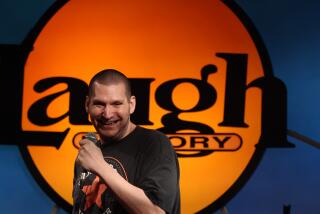A Happier Birthday for Frankie at 4
My son Frankie turned 4 last week, giving our family a chance to celebrate not just his birthday but also the progress he’s made recently overcoming the effects of infantile autism.
I first wrote about him last Christmas, at the end of a difficult year filled with anxiety over the struggles he would face his entire life dealing with a condition I thought was rare and untreatable. That column reflected my anguish at the time.
I still have concerns about Frankie. And unanswered questions about autism--mostly centered on its causes and possible cures. But for now, my hopes, and my spirits, have been lifted. That’s because the improvement in Frankie’s health has been so encouraging. A careful diet has reduced the number of colds, ear infections and stomach ailments he suffered. That in turn has made him more receptive to learning ways of coping with the most obvious symptoms of his autism--self-stimulatory behavior like hand-wringing, pacing and humming.
Only rarely does Frankie now “self-stim.” That’s a shorthand term we autism “experts” use. I mean expert in the broadest sense, including not just the researchers and clinicians I’ve interviewed on the subject but the hundreds of wonderful lay people I have heard from since that first column, who deal with autistic individuals as family, teachers or simply friends. All had valuable insights to offer.
Credit for Frankie’s progress starts with the behavior modification therapists who work with him almost every day, either at home, at his preschool or in clinical settings. His favorite is Hank Moore, who studied at UCLA under a pioneer in the treatment of autism, Dr. Ivar Lovaas. Some of Lovaas’ theories are controversial, but Frankie loves Hank. And Frankie’s mother and I, his teachers and even his little playmates, have learned how to better engage Frankie by watching him interact with his favorite “buddy,” Hank.
Frankie’s also talking a lot more. Not always clearly, and still not at the level of most 4-year-olds. But compared to the long silences of a few months ago, he’s a regular chatterbox. Lately he’s become fascinated with ocean creatures like whales and dolphins and an octopus he saw at the Monterey Bay Aquarium. Other parents may grow weary of the popular children’s song about whales called “Baby Beluga.” I can’t hear Frankie sing it enough.
But for all the hope I now have for Frankie, I am more deeply troubled than ever by how much must be done to better understand autism, and to help individuals afflicted with it.
When I assumed it was rare, for example, I was looking at data that put its prevalence at four in every 10,000 children. But those numbers reflected research done in the 1940s. A conference held last year by the National Institutes of Health concluded that two out of every 1,000 children suffer from autism symptoms, a spectrum that ranges from those so severely disabled that they must be institutionalized to children with problems like attention deficit disorder. NIH concluded that autism now is the third most common childhood disease, after mental retardation and cerebral palsy.
The lack of sufficient biomedical research into autism’s possible cures also helps explain why I mistakenly assumed it was not treatable. I’ve spoken with enough researchers to know that the question of whether autism is curable is still open to debate. But there is no doubt that it is treatable. The challenge for a family with an autistic child is in determining what treatments might work, because each case is unique. Frankie, for example, has benefited from therapies involving physical exercise and the use of music as a learning tool.
Next on the horizon for Frankie are new medical treatments, some still in the experimental stage, to deal with his physical symptoms and maybe, just maybe, help find a cure for autism.
He’s fortunate that we live in Southern California, where autism research is being done at UCLA and UC Irvine. And I might never have found out about that research without the help of a Los Angeles-based nonprofit group called Cure Autism Now (CAN) and the Frank D. Lanterman Regional Center, a state-funded agency for children with special needs.
Tellingly, CAN was founded not by medical professionals but by parents of autistic children who wanted to keep themselves abreast of research in the field. They found that it is not just woefully underfunded but also subject to widespread misunderstanding even among physicians. That is why CAN has opted to leave parent-support activities to agencies like the Lanterman Center while it focuses on identifying innovative autism research and raising money for it.
As I talk with folks at CAN and the Lanterman Center, I realize that my wife and I are going through a process of consciousness-raising. We are moving beyond anguish and starting to ask hard questions about autism--of doctors, of insurers, of schools and of elected officials responsible for health policy. For example, how much new research money will the NIH be putting into what it now ranks as the third most common childhood disease in this country?
Frank del Olmo is assistant to the editor of The Times and a regular columnist.


